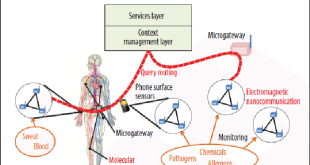In the past, the frequency spectrum ranging from 0.3 to 3THz (or 300 to 3000GHz) was spoken as infamous “Terahertz Gap” as it lies between traditional microwave and infrared domains but remained “untouchable” via either electronic or photonic means. The conventional “transit-time-limited” electronic devices can hardly operate even at its …
Read More »Nanotechnology is transforming aerospace, leading to lighter and more efficient air vehicles
The aerospace industry is one of the most important heavy industries in the world. Countless companies rely on the ability to ship products and people around the world with the speed that can only by achieved by air. Along with this huge economic value, however, comes huge consumption, and …
Read More »Columbia Engineers Revolutionize Augmented Reality (AR) Glasses through novel engineered optical materials (EnMats)
Imagine driving along the highway with directions and other pertinent information (think gas stations) appearing “on” your glasses so you ,don’t have to look away from the road. Or building a complicated DIY project with step-by-step instructions appearing “on” your glasses. Or being a first-responder unsure which way to go, …
Read More »New Breakthroughs enable Spintronic devices
Spintronics is an emerging field of nanoscale electronics which uses not only the charge of electrons but also the spin of electrons. The technology doesn’t require a specialized semiconductor material resulting in reduced manufacturing costs. Other advantages include less energy requirement, as well as low power consumption with competitive data transfer …
Read More »New field “Electron Quantum Metamaterials” giving rise to “Twisted electronics” wherein new materials can be created by varying twist angle of 2-D materials
When two atomically thin two-dimensional layers are stacked on top of each other and one layer is made to rotate against the second layer, they begin to produce patterns — the familiar moiré patterns — that neither layer can generate on its own and that facilitate the passage of light …
Read More »Internet of Nano Things (IoNT) shall impact from Telecom & IT to homeland security to military
By 2025, it is predicted that there can be as many as 100 billion connected IoT devices or network of everyday objects as well as sensors that will be infused with intelligence and computing capability. These devices shall comprise of personal devices such as smart watches, digital glasses and fitness …
Read More »Claytronics envision millions of cooperating robot modules that could morph into different shapes to serve multiple purposes
Claytronics is an abstract concept that exists at the intersection of nanotechnology, computer science and robotics. It is concerned with the development of autonomous robots, the size of a few nanometres. These nano-robots, called Claytronic atoms or catoms, can interact with each other to form three dimensional, dynamic objects that …
Read More »Graphene photonics for next generation optical communications, high speed Internet, Nanosatellites and ultrasensitive night vision for military
Cloud computing allows application software and services to be delivered from large server farms in data centers over the Internet. As more and more people use Cloud services, more and more data are created that need to be stored, transmitted and processed. This explosion of data requires larger and larger …
Read More »Nanotechnology has potential to revolutionize maritime and naval warfare environment
Nanotechnology deals with the understanding, control and manufacture of matter in the nanoscale regime, usually between 1 nm to 100 nm, and exploiting them for a useful application. At this length scale unique properties and phenomena arise as a result of increased surface-to-volume ratio and dominance of quantum mechanical effects. …
Read More »Silicon Nanowires finding applications from biological to explosive sensing, photonics Batteries to spintronics
Silicon is predicted to remain as the fundamental material for the micro- and nano-electronics industry and ultra large scale integrated (ULSI) circuits despite the ever-growing research devoted to other materials and their nano structured variants. Silicon Nanowires (SiNW) are one of the members of silicon nanostructure family, which have …
Read More » International Defense Security & Technology Your trusted Source for News, Research and Analysis
International Defense Security & Technology Your trusted Source for News, Research and Analysis








